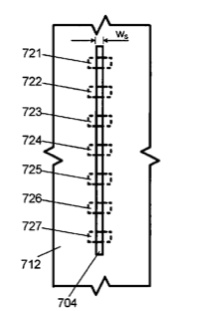Apple is eyeing ways to beef up the antennas on its iPhones as well as perhaps other iOS devices, per a patent (number 8018389) at the US Patent & Trademark Office.
The patent is entitled “methods and apparatus for improving the performance of an electronic device having one or more antennas.” It involves an electronic device comprising a first conductive unit and a second conductive unit disposed such that a gap exists between the first component and the second component. The electronic device further includes one or more components disposed along the gap and configured to counteract one or more capacitance effects in the gap, wherein at least one of the first conductive unit and the second conductive unit represents a part of an antenna. By counteracting the capacitance effects in the gap, certain radiation attributes of the antenna, such as radiation efficiency, can be improved.
The one or more components are also employed to counteract one or more capacitance effects in a slot of a conductive unit in an electronic device. The inventors are Bing Chiang, Gregory Allen Springer, Douglas B. Kough, Enrique Ayala and Matthew Ian McDonald.
Here’s Apple’s background and summary of the invention: “For electronic devices, miniaturization can provide significant advantages such as, for example, improved portability and/or reduced costs for storage, packaging, and/or transportation. However, miniaturization of an electronic device can be hindered by various physical constraints.
“For example, in an electronic device, a gap having a sufficient width between two conductive units may be required to enable the electronic device to satisfy one or more performance requirements. The performance requirements can include one or more of electromagnetic wave transmission efficiency, radio signal reception efficiency, heat dissipation efficiency, etc. If the gap is narrowed for miniaturizing the electronic device, the performance of the electronic device can be compromised. If the gap is enlarged to improve the performance of the electronic device, the form factor of the electronic device can become undesirably large.
“Techniques have been developed to physically widen the gap without enlarging the electronic device. However, the performance of the electronic device can be unacceptable in some situations when such prior art techniques are employed.
“The invention relates, in an embodiment, to an electronic device comprising a first conductive unit and a second conductive unit disposed such that a gap exists between the first component and the second component. The electronic device further includes one or more components disposed along the gap and configured to counteract one or more capacitance effects in the gap, wherein at least one of the first conductive unit and the second conductive unit represents a part of an antenna.
“In another embodiment, the invention relates to an electronic device comprising a conductive unit including a slot and one or more components disposed along the slot and configured to counter one or more capacitance effects in the slot. ”
— Dennis Sellers




